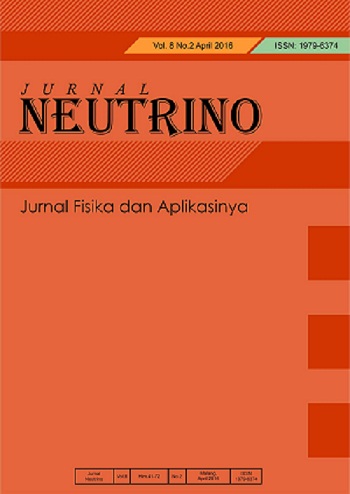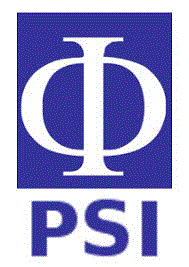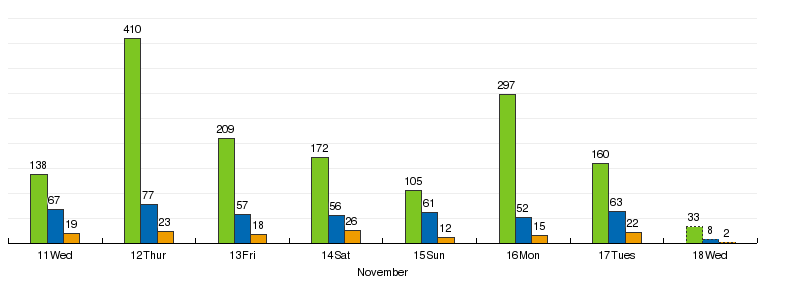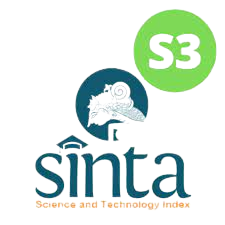Author Guidelines
1. GENERAL
Manuscripts submitted to Jurnal Neutrino:Jurnal Fisika dan Aplikasinya must be original work that has not been published or are under consideration for publication elsewhere. The journal welcomes submissions written in English. Manuscripts should be no more than 10 pages in length inclusive of tables, figures, and illustrations.
The manuscript should be typed using word processors (Microsoft Word or Open Office) software. Please use the template provided for Microsoft Word 2003 and Microsoft Word 2007.
The manuscript submitted to this journal should follow the heading below, except for the review article: Title; Authors Name; Authors Affiliation; Abstract; Keywords; Introduction; Methods; Results and Discussion; Conclusions; Acknowledgments; and References.
2. MANUSCRIPT TEMPLATE
The manuscript should be prepared according to the following author guidelines in the MS Word article template
3. GUIDELINE FOR ONLINE SUBMISSION
The author should first register as Author and/or be offered as a Reviewer through the following address: http://ejournal.uin-malang.ac.id/index.php/NEUTRINO/user/register
The author should fulfill the form as detailed as possible where the star-marked form must be entered. After all form textbox was filled, the Author clicks on the “Register” button to proceed with the registration. Therefore, the Author is brought to an online author submission interface where Author should click on “New Submission”. In the Start, a New Submission section, click on “’ Click Here’: to go to step one of the five-step submission process”. The following are five steps in the online submission process:
- Step 1 - Starting the Submission: Select the appropriate section of the journal "Articles". Thus, the author must check-mark on the submission checklists. The author may type or copy-paste the Covering Letter in Letter to Editor.
- Step 2 – Uploading the Submission: To upload a manuscript to this journal, click Browse on the Upload submission file item and choose the manuscript document file (.doc/.docx) to be submitted, then click the "Upload" button until the file has been uploaded. File size maximum 2MB
- Step 3 – Entering Submission’s Metadata: In this step, detailed authors' metadata should be entered including the marked corresponding author. After that, the manuscript title and abstract must be uploaded by copying the text and paste in the textbox including keywords.
- Step 4 – Uploading Supplementary Files: Supplementary files should be uploaded including Covering/Submission Letter. Therefore, click on the Browse button, choose the files, and then click on the Upload button.
- Step 5 – Confirming the Submission: The author should final check the uploaded manuscript documents in this step. To submit the manuscript to Jurnal NEUTRINO, click the Finish Submission button after the documents are true. The corresponding author or the principal contact will receive an acknowledgment by email and will be able to view the submission’s progress through the editorial process by logging in to the journal web address site.
4. REVIEWING OF MANUSCRIPTS
The research article submitted to this online journal will be peer-reviewed by at least 2 (two) reviewers. The decision for publication, amendment, or rejection is based upon their reports/recommendations. If two or more reviewers consider a manuscript unsuitable for publication in this journal, a statement explaining the basis for the decision will be sent to the authors within three months of the submission date.
5. REVISION of MANUSCRIPTS
Manuscripts sent back to the authors for revision should be returned to the editor without delay. Revised manuscripts can be sent to the editorial office through the Online Submission Interface. The revised manuscripts returned later than two months will be considered new submissions.
6. MANUSCRIPT PREPARATION GUIDELINES
6.1 Manuscript Heading, Font, and Spacing
Manuscript should be typed using word processors (Microsoft Word or Open Office) software. The body of the text is a set of body text paragraphs defined as follows:
- 12pt Times New Roman.
- A4 (i.e., 210 x 297mm) paper size
- Two-column format
- Lines are single spaced, justified.
- Page numbers should be included in the text located at the top of the page [brackets] section of each page.
- Margin format : Top (2.5 cm), Botton (2.5 cm), Left (2.5 cm), Right (2 cm)
6.2 Tables
Tables are sequentially numbered with the table title and number above the table. Tables should be centered in the column OR on the page. Tables should be followed by a line space (12pt). Elements of a table should be single-spaced, however, double spacing can be used to show groupings of data or to separate parts within the table. Table headings should be in 10pt bold. Tables are referred to in the text by the table number. eg: Table 1. Do not show vertical lines in the table. There is only a horizontal line that should be shown within the table.
6.3 Figure
Figures are sequentially numbered commencing at 1 with the figure title and number below the figure as shown in Figure 1. Detailed recommendations for figures are as follows:
- Ensure that figures are clear and legible with typed letterings.
- Black & white or colored figures are allowed.
- If a figure spans two columns, it should be placed at the top or bottom of a page.
- Hard copy illustrations should, preferably, be scanned and included in the electronic version of the submission in an appropriate format as follows:
- BMP - Microsoft bitmap file
- JPG
- If figures cannot be scanned, the original should be placed in its location within the manuscript using wax or colorless glue.
- The following files are permissible:
- Microsoft Graph
- Microsoft Draw
6.4 Equations
Equations should be numbered serially within parentheses as shown in Equation (1). The equation should be prepared using MS Equation Editor (not in image format). The equation number is to be placed on the extreme right side.
6.5 Units, Abbreviations, and Symbols
SI units are preferred. Define abbreviations and symbols for the first time as they are introduced in the text.
6.6 Abstract and Keywords
All manuscripts should be accompanied by an abstract, of word limitation (100- 250 words), written in English, with one spacing, and 10 pt Times New Roman format. The abstract should not only indicate the subject and scope of the paper but also summarize the author’s conclusion along with at least three (3) keywords that could be useful for information-retrieval purposes.
6.7 Title
This is your opportunity to attract the reader’s attention. Remember that readers are the potential authors who will cite your article. Identify the main issue of the paper. Begin with the subject of the paper. The title should be accurate, unambiguous, specific, and complete. Do not contain infrequently-used abbreviations.
The title of the paper should be in 16 pt bold Times New Roman and be centered. 15 words in maximum. The title should have 0 pts space above and 14 pts below.
6.8 Author's Name and Affiliations
Write Author(s) names without title and professional positions. Do not abbreviate your last/family name. Always give your First and Last names. Write clear affiliation of all Authors. Affiliation includes the name of the department/unit, (faculty), name of the university, and country. Please indicate Corresponding Author (include email address) by adding an asterisk (*) in superscript behind the name. Author names should be in 12 pt Times Roman with 12 pts above and 12 pts below.
6.9 Introduction
In the Introduction, the Authors should state the objectives of the work at the end of the introduction section. Before the objective, the Authors should provide an adequate background, and a very short literature survey in order to record the existing solutions/method, to show which is the best of previous research, to show the main limitation of the previous research, to show what do you hope to achieve (to solve the limitation), and to show the scientific merit or novelties of the paper. Avoid a detailed literature survey or a summary of the results.
6.10 Methods
Materials and methods should make readers able to reproduce the experiment. Provide sufficient detail to allow the work to be reproduced. Methods already published should be indicated by a reference: only relevant modifications should be described. Do not repeat the details of established methods.
6.11 Results and Discussion
Results should be clear and concise. The results should summarize (scientific) findings rather than provide data in great detail. Please highlight the differences between your results or findings and the previous publications by other researchers.
The discussion should explore the significance of the results of the work, not repeat them. A combined Results and Discussion section is often appropriate. Avoid extensive citations and discussion of published literature.
In discussion, it is the most important section of your article. Here you get the chance to sell your data. Make the discussion correspond to the results, but do not reiterate the results. Often should begin with a brief summary of the main scientific findings (not experimental results). The following components should be covered in the discussion: How do your results relate to the original question or objectives outlined in the Introduction section (what)? Do you provide an interpretation scientifically for each of your results or findings presented (why)? Are your results consistent with what other investigators have reported (what else)? Or are there any differences?
6.12 Conclusions
Conclusions should answer the objectives of the research. Tells how your work advances the field from the present state of knowledge. Without clear Conclusions, reviewers and readers will find it difficult to judge the work, and whether or not it merits publication in the journal. Do not repeat the Abstract, or just list experimental results. Provide a clear scientific justification for your work, and indicate possible applications and extensions. You should also suggest future experiments and/or point out those that are underway.
6.13 Acknowledgment
Recognize those who helped in the research, especially funding supporters of your research. Include individuals who have assisted you in your study: Advisors, Financial supporters, or many other supporters i.e. Proofreaders, Typists, and Suppliers who may have given materials.
6.14 References
The minimum number of references should be 15 references. Reference should be 75% from primary sources (journals, proceedings) and 25% from secondary (books, etc.). References no more than the last 10 years. It is arranged sequentially based on the serial number on the citation and written using the Vancouver style. Citation of references is used by writing the name of the author or writing numbers referenced library at the end of a sentence. Please use reference software like Mendeley, Zotero, etc to make the citation work easier.
Example
For print Journal:
1. McInnes D, Snowdon J. Severe depression in old age. Medicine Today. 2021 Dec;3(12):40-47.
For books:
2. Cheers B, Darracott R, Lonne B. Social care practice in rural communities. Sydney: The Federation Press; 2019.
For online article/electronics journal:
3. Lemanek K. Adherence issues in the medical management of asthma. J Pediatr Psychol [ Internet]. 2016 [cited 2016 Apr 22];15(4):437-58. Available from:HTTP:// jpepsy.oxfordjournals.org/cgi/reprint/15/4/437
For Theses (printed) :
4. Author. Thesis Title. Place of Publication: Publisher; Year.
For Online Thesis:
5. Author. Thesis title [type of thesis on the internet]. Place of publication: Publisher; Year [cited 2019 Mar 24]. Available from: Name of database/web address
For Internet References:
6. Author. Title of publication [type of medium – Internet]. Place of publication (if available): Publisher (if available); Date of publication – year month day (supply year if month and day not available) [updated 2010 Feb 10; cited 2010 Apr]. Available from: web address.
For published conference paper:
7. Author(s) of paper – Family name and initials. Title of paper. In: Editor(s) Family name and initials, editor(s). Title of conference; Date of conference; Place of conference. Place of publication: Publisher’s name; Year of publication. p. Page numbers.
For Proceedings:
8. Kimura J. Shibasaki H, editors. Recent advances in clinical neurophysiology. Proceedings of the 10th International Congress of EMG and Clinical Neurophysiology; 2017 Oct 15-19; Kyoto, Japan. Amsterdam: Elsevier; 2017. P.61
For Electronic Journal (online article) with DOI:
9. Fletcher D, Wagstaff CRD. Organisational psychology in elite sport: its emergence, application and future. Psychol Sport Exerc. 2017;10(4):427-34. doi:10.1016/j.psychsport.2017.03.009.
7. Author Fee (Article Processing Charge - APC)
Starting from the manuscript publishing on October 2023, the Author(s) should pay an Article Processing Charge (APC) of Rp. 400.000,- per article, once the manuscript was accepted. An invoice will be sent to the Authors whose article was accepted. Please be noted that the payment of APC can be proceeded by bank transfer which will be informed to the Corresponding Author together with the invoice. The accepted articles will not be published until the APC was paid by Author(s). The APC will be used to maintain the DOI registration and the full-text PDF articles production cost.
For Further Information, Please Contact Editor in Chief (Cecep E. Rustana)











